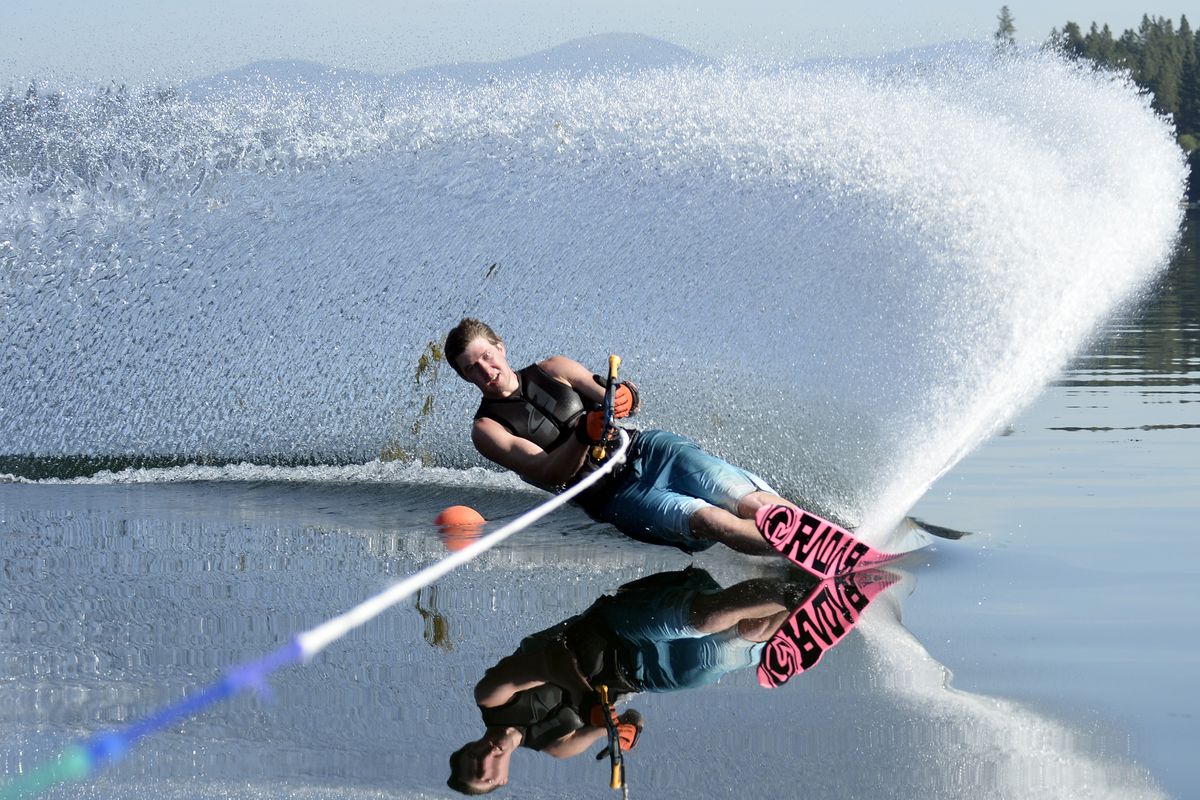Kienbaum family of Liberty Lake knows how to carve up the glassy water

Genevieve Kienbaum, 10, glided through the slalom course with an easy grace that would make most grownups envious. She’s the youngest of Liberty Lake’s waterskiing Kienbaums, a family that competes on a national level. The kids were getting in some practice shortly after returning from the 2014 U.S. Western Regional Waterski Championships July 24-26 in Winsor, Colorado.
Nearly every Kienbaum brought back hardware from the tournament except for the patriarch. Paul, 52, wore a walking boot after tearing ankle ligaments in a crash at an event in Seattle earlier this summer. He oversees a stable of athletes including his wife Juli, 50, and five of their six children (the oldest is busy with motherhood and nursing school). Together they travel the country, pursuing the art of whipping around buoys at highway speeds clutching the end of a rope.
“We pack the whole family along for eight to 10 tournaments a season,” said Paul, a partner with Alliant Securities, Inc. in Liberty Lake. “Everyone jumps in the RV and we camp right on site. We do three-event skiing, which is slalom, our specialty, plus trick and jump skiing. Most of the kids do all three events. I stick with slalom.”
The Kienbaum’s compete in events sanctioned by the American Water Ski Association (AWSA). These adrenalin-powered triathlons keep the whole family busy.
Trick competitors ride small, oval-shaped skis in two, 20-second passes in front of a panel of judges. One pass is for hand tricks, which include side slides, spins, and flips. The other pass is for toe tricks, which the skier performs “holding” onto the rope handle with one foot. The skier with the most points wins.
At the regional championships, Mary Kienbaum, 16, won the medal for most improved skier in the trick as well as slalom events. Her sister Grace, 14, took fifth in trick and Genevieve took fourth on her way to third place overall in her age group.
Jumpers reach speeds up to 60 mph approaching a ramp that launches them through the air on long, wide, flat skis. A successful attempt requires skiing away at least 100 feet after touching down. The skier with the most distance over three attempts wins. You have to stick the landing, but there are no style points. Juli Kienbaum was the regional silver medalist in jump. Genevieve placed fourth.
Slalom skiers rip turns around six buoys. In a tournament, the boat speeds up 2 mph on each consecutive pass until the maximum speed is reached for the division. Once at maximum speed, the rope is shortened with each pass. Miss a buoy or crash and you’re out.
A waterski rope is 75 feet long. Charlie Kienbaum (23) and his brother Matt (19) typically reach the maximum speed of 36 mph with a rope shortened to 40 feet, or “35 off.” Both compete for the Western Washington University water ski team, which placed second in the 2013 collegiate Division II nationals.
At this speed and rope length, they can approach turn buoys at speeds approaching 70 mph and fight up to 4 g of force in the turns. To withstand such loads, slalom skiers use their body as a lever.
“Slalom is all about acceleration and deceleration,” Paul said. “You’ve got to slow down going into the buoy, then speed up. When you pull the line going through the wake you have to picture your body like a pencil and keep the handle tight on your hip. Instead of fighting against the boat, you’re using leverage and the boat is pulling you. But if the handle gets away from you, your body pays the price.”
Among the Kienbaums, Genevieve fared best in her age group in slalom, finishing fifth. Juli and Charlie finished sixth in their divisions. Matt took seventh in slalom on his way to seventh overall.
The family’s results are impressive, considering the training advantages enjoyed by most of their competitors. The closest jump is in Moses Lake and top skiers typically come from the southern latitudes.
“A lot of the people we compete with are from the south and southwest, where they live on private lakes and ski 12 months a year any time of the day,” Paul said. “We have to get up at five or six a.m. for the flat water and ski maybe six months out of the year.”
To compete at their level, the Kienbaums start skiing in drysuits as soon as the ice melts. But the excitement of tournament waterskiing doesn’t necessarily require such an intense commitment. Paul suggests keeping an eye on the schedule for the Washington INT League, which sanctions all-comers events at the Sun Basin Ski Ranch on Moses Lake, the closest tournament site to Spokane.
“You can compete at any level,” Paul said. “Seriously, if you can get up on a slalom ski you can go to a tournament. Your next buoy is your next challenge. It’s like golf. It doesn’t matter if you’re a scratch golfer or a bogey golfer. You can still play.”